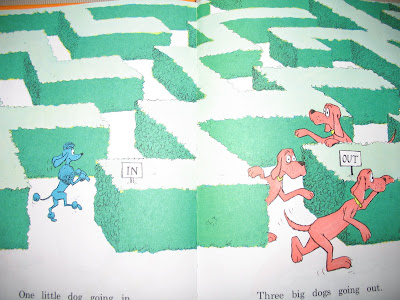I was pretty sure I knew what that was, so I asked, "Does that mean read all the Dr. Seuss books?"
"No, because there are some we don't have" was his response.
"Oh." I tried again. "Does it mean read all the ones we have in the house?"
"No," he replied, very patiently. "It just means all the ones I can find."
This turned out to be a formidable stack.

We read Dr Seuss's ABC, The Cat in the Hat, Green Eggs and Ham, There's a Wocket in my Pocket, Go Dog Go! (yes, I know, it's P. D. Eastman, but Little was looking at the picture of the Cat in the corner) The Cat in the Hat Comes Back, and One Fish Two Fish Red Fish Blue Fish. This was a luxurious experience for Little One, akin to what spending the morning knitting in my pjs would be (ahem, is) for me. It is also the kind of experience that I would have thought we would be able to have all the time, whenever he asked, when I decided to be their mom and educator all day every day. I really thought we'd be able to do this sort of thing all the time, but even in a homeschool house, there is time for some things and not others. All too often I am too busy with something-or-other to sit down and read to him for such an extended time.
But this morning, that's just what we did, and it's got me thinking about the ways I read to a non-reader that support his developing literacy. These are the things that parents who love reading do naturally, because we want our kids to understand what we're reading.
With a book like Go Dog Go, we (you, me, all the parents I know) tend to point to the pictures in a way that helps our very young children understand the words, because a basic speaking vocabulary is one thing you need to learn to read. So for example, when we get to a page like this:

We naturally point to the little dog who is going in, and the three big dogs who are going out. This helps a child understand what those words mean, but perhaps more importantly to the literacy project, it lets the child know that these noises that we use to communicate (words) have a corresponding life in books. In other words, this helps a child construct a concept of written language, and how spoken language becomes written language. This is not rocket science, but rather what we naturally do to invite children into the world of books. It is the very beginning of teaching reading.
For a child a little further along, but not yet reading, I might follow along with a finger as I read a line of text. This is essential for a child to understand that text moves from left to right in written English, but it's best left out for a very young child who is really not ready or interested in this information. For a very young child, we just want to invite them into the book and make the reading as enjoyable and fluid as possible. But for an older child who knows his letters and that they make sounds, and is almost ready to read, I will move my finger along under the line as I read it. I want my reading to sound fluent and smooth, not choppy and word by word. It's important for kids to see and hear adults reading well.
With Little this morning, as I read The Cat in the Hat, I would sometimes get to the end of a line and leave the last word out, pausing expectantly for him to fill it in. I would do this only when the word made sense in context, and when there had been a word in a preceeding line that gave a clue about the rhyme. This is much simpler than it might sound. Here's an example:
We looked!
Then we saw him step in on the mat!
We looked!
And we saw him!
The Cat in the ___!
Kids with even a little bit of familiarity with the text will get this easily, and it really helps them start to see themselves as readers. I usually say something like, "That was really good reading" when we do this, and it really is reading, believe it or not.
At one point, Little said, "I just said the thing that made sense, I didn't really know the word." I told him that that's reading too, that a lot of times when we don't know a word, we can make a guess that makes sense for the story. You can tell a lot about what your child knows by the guesses he makes!
My point here is that we don't need to use curricula and worksheets and flash cards and whatnot to teach children to read. I would probably take the position that we don't need these things for teaching any subject, but that would be a digression. All we have to do is read to them, and experience the texts with them in ways that help them unlock the code.

3 comments:
Lucky LittleOne, and lucky you, to be able to do this and then reflect on it. Sounds like a great day!
Nice picture, too -- did BigOne take it?
I'm partially responsible for this Dr. Seuss event, now that I think about it. When I unpacked the books in Little's new bedroom, the former library assistant in me put all the Dr. Seuss books together on the shelf.
So funny that Little noticed it and ran with it!
Well thank you very much, Mama Chief. It was a fun morning. He likes order quite a bit, and clearly appreciated your librarianism.
Post a Comment